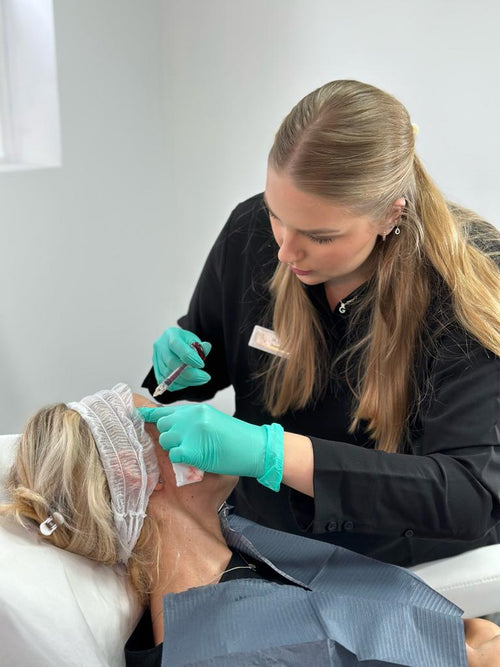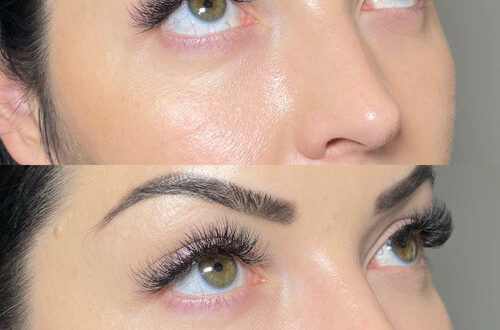Book a Consultation for Dermal Fillers with Dr. Laura Geige at It’s Me and You Clinic
Facial Harmony
The Golden Ratio
Facial harmony refers to the pleasing arrangement and proportions of facial features. It’s a concept that has fascinated artists, scientists, and philosophers for centuries, as it relates to our perception of beauty and balance.
The Golden Ratio, often represented by the Greek letter phi (Φ), is an irrational number approximately equal to 1.618. This ratio appears frequently in nature, art, and architecture, and has been linked to aesthetic appeal.

In facial proportions, the Golden Ratio is sometimes used as a guideline for ideal symmetry and balance.
The idea suggests that when facial features are arranged according to this ratio, they appear more harmonious and attractive. For example, the distance between the eyes, the width of the nose, and the length of the lips may be measured in relation to each other using the Golden Ratio as a guide.
However, it’s crucial to remember that the Golden Ratio is just one theoretical framework for understanding facial beauty.
Individual preferences, cultural influences, and personal experiences all play a role in what people find attractive.
Furthermore, applying rigid mathematical ratios to faces can lead to unrealistic beauty standards and potential harm to individuals who may not conform to these ideals.
Regarding the specific question of whether the top or bottom lip should be bigger, there’s no single definitive answer based on the Golden Ratio or any other universal standard.
Facial proportions vary widely among individuals, and what is considered aesthetically pleasing will differ from person to person.
Ultimately, beauty is subjective, and individual features should be celebrated for their uniqueness rather than judged against arbitrary guidelines.
Individual Variation and Attractiveness
Facial harmony refers to the balanced and proportionate arrangement of facial features, creating a sense of visual appeal and aesthetic satisfaction. It’s not just about individual features being “beautiful” but rather how they work together to create a cohesive and pleasing whole.
Get Your Dermal Filler Consultation with Dr. Laura Geige at It’s Me and You Clinic
Individual variation is a fundamental aspect of human beauty. There’s no single set of facial proportions that universally defines attractiveness. Variations in lip size, facial shape, bone structure, skin tone, and other features contribute to the vast diversity we see in faces.
Cultural and societal influences also play a significant role in shaping perceptions of attractiveness. Different cultures may have varying preferences for facial features, highlighting the subjective nature of beauty standards.
Regarding lip size specifically, it’s crucial to understand that balance is key. While some individuals might find larger lips more attractive, others might prefer smaller ones. What matters most is that the lips are proportionate to other facial features and create a harmonious overall appearance.
There is no definitive “top” or “bottom lip should be bigger” rule. It depends on individual facial anatomy and the desired aesthetic.
Here’s a breakdown of factors to consider:
-
Lip thickness in relation to other features: Lips that are too thick or too thin relative to the nose, chin, and cheekbones can disrupt facial harmony.
-
Facial shape: Individuals with round faces may find fuller lips more balanced, while those with angular features might prefer slightly thinner lips.
-
Personal preference: Ultimately, the best lip size is one that the individual feels comfortable and confident with.
It’s important to remember that beauty standards are constantly evolving. What’s considered attractive in one era may not be as popular in another. The most important thing is to embrace your unique features and celebrate the diversity of human beauty.
Beyond Aesthetics: Function and Expression
Lip Size and Speech
While aesthetics play a role in perceptions of facial beauty, it’s crucial to remember that lip size significantly impacts ***speech*** and ***function***.
The lips are intricate structures involved in numerous physiological processes beyond mere appearance. They are essential for
-
***Articulation***: The precise movements of both the upper and lower lips are crucial for forming distinct sounds, particularly vowels and consonants.
-
***Resonance***: The lips act as resonating chambers, influencing the tone and quality of our voice.
-
***Breath Control***: The lips play a role in regulating airflow during speech, contributing to proper pronunciation and fluency.
-
***Oral Hygiene***: Lips help prevent food debris from entering the mouth and contribute to maintaining oral hygiene.
The ideal lip size for optimal speech varies depending on individual anatomy and speaking styles. However, drastically disproportionate lip sizes can lead to:
-
Speech impediments
-
Difficulties in producing certain sounds
-
Changes in vocal quality
Surgical procedures like lip augmentation should be approached with caution. While enhancing aesthetics may seem appealing, it’s vital to prioritize the functional integrity of the lips.
Focusing solely on maximizing either the top or bottom lip size without considering the overall balance and functionality can result in unintended consequences for speech and communication.
Smiling and Emotional Conveying
The question of whether the top or bottom lip should be bigger delves into a fascinating intersection of aesthetics, function, and emotional expression. While societal beauty standards often promote specific lip proportions, understanding the biological and communicative roles of our lips provides a more nuanced perspective.
From a functional standpoint, both the top and bottom lips play crucial roles in speech articulation, eating, and breathing. The upper lip shapes vowels, assists in nasal resonance, and helps control airflow during speaking. The lower lip contributes to pronunciation of consonants, especially those involving plosives and labial sounds.
Beyond these practical functions, our lips are powerful tools for nonverbal communication. They convey a wide range of emotions, from happiness and joy to sadness and anger. The subtle movements and shapes of the lips play a significant role in interpreting facial expressions.
Smiling, a universal expression of positive emotion, primarily involves the contraction of the zygomaticus major muscle, lifting the corners of the mouth. This upward pull engages both the upper and lower lips, creating the characteristic curve associated with smiling. The degree of lip fullness can influence the appearance of the smile, but the fundamental act of smiling transcends specific lip proportions.
Similarly, other expressions like frowning, puckering, or pursing the lips rely on a complex interplay of muscle movements involving both the upper and lower lip. These expressions communicate a range of emotions and intentions, conveying information beyond spoken words.
It’s important to remember that individual facial features, including lip size and shape, vary significantly across populations. There is no single “ideal” lip proportion that defines beauty or attractiveness. Cultural norms and personal preferences influence perceptions of what is considered aesthetically pleasing.
Reserve a Dermal Filler Consultation with Dr. Laura Geige Now
Ultimately, focusing solely on the relative size of the top or bottom lip overlooks the complexity and richness of human facial expression. Our lips are integral parts of a larger communicative system, working in concert with other facial muscles, gestures, and tone of voice to convey a vast spectrum of emotions and meanings.
Azmia Magane Derwen Roots Humboldt Apothecary CBD The New Cinema Magazine Plinr
- How To Help With Lip Filler Swelling - October 1, 2025
- How Gaslighting Disrupts The Emotional Balance In Relationships - September 29, 2025
- Gummy Smile Treatment – Gum Contouring Near Compton, Surrey - September 26, 2025





